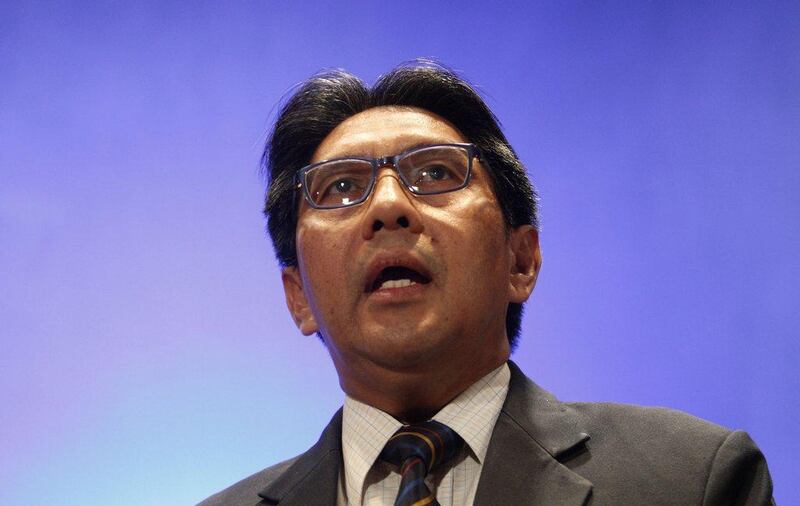KUALA LUMPUR // Vietnamese searchers on ships worked throughout the night but could not find a rectangle object spotted Sunday afternoon that was thought to be one of the doors of a Malaysia Airlines passenger jet that went missing more than two days ago.
Doan Huu Gia, the chief of Vietnam’s search and rescue coordination centre, said Monday that four planes and seven ships from Vietnam were searching for the object but nothing had been found.
Boats and aircraft have now homed in on a remote Vietnamese island after possible debris was spotted floating nearby.
Two objects were seen from the air late Sunday some 80 kilometres off Tho Chu island, in what Vietnamese authorities said could be a breakthrough sighting of debris from the disappeared jet.
The discovery has helped Vietnamese sea and air teams refine their hunt for Malaysia Airlines (MAS) flight MH370 to a zone near the small island off Vietnam’s southwestern tip.
“All night we mobilised our most modern equipment for the search ... but we found no sign of the objects,” Vice Admiral Ngo Van Phat said.
“Two boats left this morning to patrol all maritime zones around Tho Chu Island where we discovered the two objects.”
The Boeing 777 went missing early Saturday morning on a flight from Kuala Lumpur to Beijing with 239 people on board.
The plane lost contact with ground controllers somewhere between Malaysia and Vietnam, and searchers in a low-flying plane spotted an object that appeared to be one of the plane’s doors, the state-run Thanh Nien newspaper said, citing the deputy chief of staff of Vietnam’s army, Lt Gen Vo Van Tuan.
The jetliner apparently fell from the sky at cruising altitude in fine weather, and the pilots were either unable or had no time to send a distress signal, adding to the mystery over the final minutes of the flight.
There are also questions over how two passengers managed to board the ill-fated aircraft using stolen passports.
Interpol confirmed it knew about the stolen passports but said no authorities checked its vast databases on stolen documents before the Boeing jetliner departed Saturday.
Warning “only a handful of countries” routinely make such checks, Interpol secretary general Ronald Noble chided authorities for “waiting for a tragedy to put prudent security measures in place at borders and boarding gates.”
On Saturday, the foreign ministries in Italy and Austria said the names of two citizens listed on the flight’s manifest matched the names on two passports reported stolen in Thailand.
“I can confirm that we have the visuals of these two people on CCTV,” Malaysian Transport Minister Hishammuddin Hussein said at a news conference late Sunday, adding that the footage was being examined. “We have intelligence agencies, both local and international, on board.”
The thefts of the two passports — one belonging to Austrian Christian Kozel and the other to Luigi Maraldi of Italy — were entered into Interpol’s database after they were stolen in Thailand in 2012 and last year, the police body said.
Electronic booking records show that one-way tickets with those names were issued Thursday from a travel agency in the beach resort of Pattaya in eastern Thailand. A person who answered the phone at the agency said she could not comment.
But no authorities in Malaysia or elsewhere checked the passports against the database of 40 million stolen or lost travel documents before the Malaysian Airlines plane took off.
Possible causes of the crash included some sort of explosion, a catastrophic failure of the plane’s engines, extreme turbulence, or pilot error or even suicide. Establishing what happened with any certainty will need data from flight recorders and a detailed examination of any debris, something that will take months if not years.
Malaysia’s air force chief, Rodzali Daud, said radar indicated that before it disappeared, the plane may have turned back, but there were no further details on which direction it went or how far it veered off course.
“We are trying to make sense of this,” Daud said at a news conference. “The military radar indicated that the aircraft may have made a turn back, and in some parts this was corroborated by civilian radar.”
Malaysia Airlines Chief Executive Ahmad Jauhari Yahya said pilots are supposed to inform the airline and traffic control authorities if the plane does a U-turn. “From what we have, there was no such distress signal or distress call per se, so we are equally puzzled,” he said.
A total of 34 aircraft and 40 ships from Vietnam, Malaysia, Thailand, Australia, Singapore, Indonesia, China and the United States were deployed to the area where ground controllers lost contact with the plane on the maritime border between Malaysia and Vietnam.
Of the 227 passengers and 12 crew members on board, two-thirds were Chinese, while the rest were from elsewhere in Asia, Europe and North America, including three Americans.
Family members of Philip Wood, a 50-year-old IBM executive who was on board the plane, said they saw him a week ago when he visited them in Texas after relocating to Kuala Lumpur from Beijing, where he had worked for two years.
The other two Americans were identified on the passenger manifest as 4-year-old Nicole Meng and 2-year-old Yan Zhang. It was not known with whom they were traveling.
After more than 30 hours without contact with the aircraft, Malaysia Airlines told family members they should “prepare themselves for the worst,” Hugh Dunleavy, the commercial director for the airline, told reporters.
Finding traces of an aircraft that disappears over sea can take days or longer, even with a sustained search effort. Depending on the circumstances of the crash, wreckage can be scattered over a large area. If the plane enters the water before breaking up, there can be relatively little debris.
A team of American experts was en route to Asia to be ready to assist in the investigation into the crash. The team includes accident investigators from the National Transportation Safety Board, as well as technical experts from the Federal Aviation Administration and Boeing, the safety board said in a statement.
Malaysia Airlines has a good safety record, as does the 777, which had not had a fatal crash in its 19-year history until an Asiana Airlines plane crashed last July in San Francisco, killing three passengers, all Chinese teenagers.
Details also emerged Sunday about the itineraries of the two passengers traveling on the stolen passports.
A telephone operator on a China-based KLM hotline confirmed Sunday that passengers named Maraldi and Kozel had been booked on one-way tickets on the same KLM flight, flying from Beijing to Amsterdam on Saturday. Maraldi was to fly on to Copenhagen, Denmark, and Kozel to Frankfurt, Germany.
She said the pair booked the tickets through China Southern Airlines, but she had no information on where they bought them.
As holders of EU passports with onward flights to Europe, the passengers would not have needed visas for China.
Interpol said it and national investigators were working to determine the true identities of those who used the stolen passports to board the flight. White House Deputy National Security Adviser Tony Blinken said the US was looking into the stolen passports, but that investigators had reached no conclusions.
Interpol has long sounded the alarm that growing international travel has underpinned a new market for identity theft: Bogus passports are mostly used by illegal immigrants, but also pretty much anyone looking to travel unnoticed such as drug runners or terrorists. More than 1 billion times last year, travellers boarded planes without their passports being checked against Interpol’s database of 40 million stolen or lost travel documents, the police agency said.
* Associated Press





